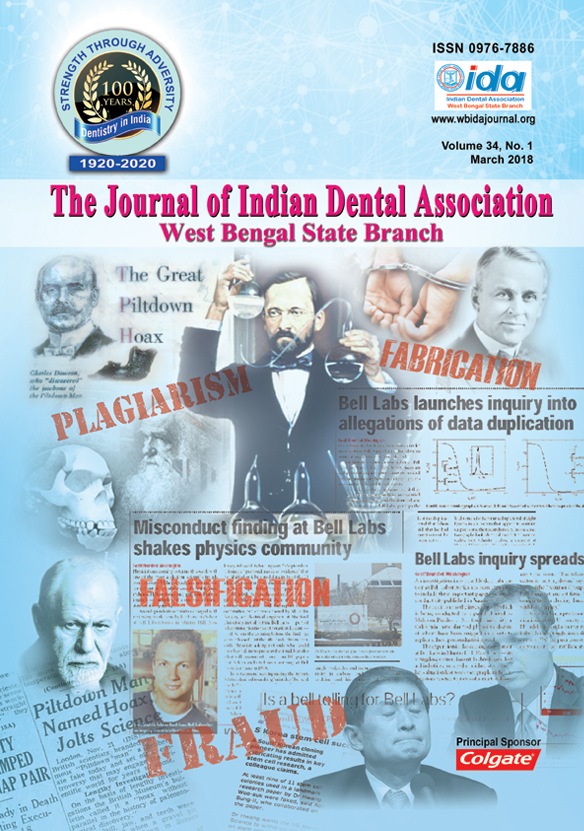Upcoming Events
1. Article Title.
2. Author Details.
3. Abstract.
4. Keywords.
5. Corresponding Author details.
March 2018
Volume : 34
No.: 1

Dr. Sanjoy Das,Dr. Sourav Saha,Dr. Satyaki Das,Dr. Sanjit Lal Das,Dr. Ankan Kumar Maji,Dr. Shambaditya Pahari
Abstract: Creating a functional and esthetic rehabilitation of occlusion is extremely rewarding for the dentist as well as for the patient. It is very important to re-establish proper occlusal plane for teeth replacement to prevent harmful sequalae to the stomatognathic system. Aim: Tocompare the amount of deviation of occlusal plane in subjects having missing posterior teeth with normal one. Methodology- Impressions were made for 40 patients and models were articulated in a 'Hanau' semi adjustable articulator. A custom made Broadrick Flag was fabricated and used to measure the deviation of the occlusal plane from an ideal one. Result- Measurements were recorded and 'paired t test' was done. A statistically significant difference p<0.05 was found in the deviation. Conclusion- It can be concluded that the Broadrick flag method should be used in determining an appropriate occlusal curve for individuals with deranged occlusal planes for precise prosthetic or restorative treatment.
Dr. Anwesha Adak,Prof. (Dr.) Subrata Saha,Prof. (Dr.) Subir Sarkar,Dr. Nilanjana Saha,Dr. Shubhabrata Pal
Abstract: Maintenance of arch length during the primary, mixed and early permanent dentition is of great significance for the normal development of future occlusion. Premature loss of primary tooth before natural shedding time can result in arch length deficiency leading to malocclusion. Early interception and prevention of developing malocclusion reduce or eliminate the need for complex orthodontic treatment in later stage. Appropriate space maintainer appliance should be advocated for holding the space until the eruption of permanent teeth. This article has reviewed and summarized the different types of space maintainers, their selection, indication, contraindication, advantages, disadvantages in treatment of primary and mixed dentition stage.
Dr. Shekhar Prasad,Dr. Ashish Pandey,Dr. Gautam Bagchi
Abstract: The use of dental implants to provide support for replacement of missing teeth has a long and multifaceted history. Conventional implants are indicated in situations when an adequate vertical bone is present. Restoration of moderate to severely atrophic jaws with conventional implants requires extensive and expensivesurgical procedures, like ridge augmentation, sinus lift. Basal implants are specifically designed to allow fixed rehabilitation in severely atrophic jaws.They derive support from the basal bone area which usually remains free from the infection and less prone to resorption. Through this article we propose a classification for basal implants and enlighten on their morphology and also explain in detail about the various aspects of these implants.
Dr. Swapan Kumar Majumdar,Dr. Chandmani Tigga,Dr. Sanjoy Roy,Dr. Mustafizur Rahaman,Dr. Siddartha Mishra,Dr. Divya Chadda,Dr. Malay Kanti Bachhar
Abstract: Nasal fracture are the most common facial fracture (51.3%) followed by the zygomatic-orbital fracture (25.1%) in the middle third of face. Most common causes of these injuries are falls and motor vehicle accidents (MVAs) .We report a case of nasal injury including mid and lower facial fractures leading to nasal and facial deformities. We did external rhinoplasty and ORIF (Open Reduction internal fixation) simultaneously. It improved the patient's functional outcome and facial appearance.
Dr. Subhasish Burman,Dr. Mustafizur Rahaman,Dr. Sanjoy Roy,Dr. Siddartha Mishra,Dr. Chandan Sahana
Abstract: Sub condylar fracture associated with contralateral para symphysis fracture is a common type of fracture associated with mandibular fracture. In our centre several cases of this combination fracture presents after personal violence or due to road traffic accident. This type of fracture can be reduced either with open or closed reduction. Ramal height shortening remains the main problem associated with closed reduction of sub condylar fracture. So patient presenting with this kind of fracture can be managed through open reduction internal fixationusing retromandibular approach. This paper presents a case report of sub condylar fracture with contralateral parasymphysis fracture treated with ORIF through retromandibular approach and an intraoral degloving incision.
Dr. Sutanu Modak,Prof. (Dr.) Rup Kumar Das,Dr. Anirban Shome,Dr. Divya Chadda,Dr. Swapan Majumdar,Dr. Nupur Banerjee
Abstract: Orthognathic surgery is one of the treatment modality in adult patients in severe jaw discrepancies. It can be done in case of maxillary, mandibular or bi-maxillary deformity. A patient reported with a chief complaint of forward positioning of lower jaw. Pre-surgical orthodontic decompensation was done. Then prediction tracing and mock surgery was performed to detect the amount of setback to be needed. After that a surgical splint was constructed and the patient was referred to the Dept of Oral and Maxillofacial surgery for bilateral sagittal split osteotomy. After that the patient was referred back to the Orthodontic department for post surgical Orthodontics. Final settling was done. After that debonding was done and upper and lower canine to canine bonded retainer was given.
Dr. Anusree Paul,Dr. Bides Bhaumik,Dr. Amal Kumar Chakrabarti,Dr. Kesang Drolma
Abstract: Extraction of teeth in orthodontics is always a matter of controvercy. In recent years, extraction of single mandibular incisor in orthodontic treatment is gaining popularity due to its simple mechanics and various long term advantages in mandibular crowding cases. Moreover, less visibility of the lower dentition during smile, specially in females, has supported this treatment option from an esthetic point of view. This article is presenting a case report of a 17 years old female orthodontic patient treated by single lower incisor extraction.
Dr. Aman Kumar,Dr. Bides Bhaumik,Dr. Bimalendu Saha,Dr. Ali Asger Nakib,Dr. Susmita Choudhary
Abstract: Treatment of the Class III malocclusion poses a challenge to the clinician. The timing of treatment varies from early intervention during the pre-pubertal stages of growth, to intervention after the patient has completed their active growth. The treatment modalities range from dentofacial orthopaedic treatment, to camouflage orthodontic treatment, to a combined orthognathic surgical and orthodontic approach. The present case report shows early treatment of a young female patient with severe transverse and sagittal discrepancy of the maxilla and mandible, using a facemask.
Dr. Debasish Kar,Dr. Sanjeet Kumar Das,Prof. (Dr.) Mousumi Pal
Abstract: Tuberculosis, a chronic infective granulomatous disease, is still one of the most prevalent disease in developing countries. Globally effectiveness of DOTS therapy, vaccination, and education has led to the decreased prevalence of tuberculosis in recent years, although pulmonary and extra-pulmonary tuberculosis, especially the tubercular lymphadenitis, is still relatively common in the developing countries like India; but rarely affects oral cavity. Here, a case of an elderly female is presented with the complaint of non-healing ulcer of right buccal mucosa of 6-months duration mimicking squamous cell carcinoma. Incisional biopsy followed by histopathological evaluation revealed a chronic granulomatous infective disease which was later confirmed to be tuberculosis. The purpose of this presentation is to sensitize clinicians to consider oral tuberculosis in differential diagnosis of patients with non-healing oral ulcer.
Dr. Selim Akhtar,Dr. Sudipto Roy,Dr. Aindrila Ghosh
Abstract: Pleomorphic adenoma or benign mixed tumor is the most common salivary gland neoplasm that commonly occurs in major glands, but may also affect the intraoral minor glands. The lips are common mucosal sites, second only to the palate, where they usually present as a freely movable, circumscribed mass. From both diagnostic and therapeutic standpoint, complete surgical removal with adequate margin followed by histopathological evaluation is recommended. The present report describes a case of 25-year-old male with asymptomatic nodular swelling of upper lip which was later diagnosed as pleomorphic adenoma.












